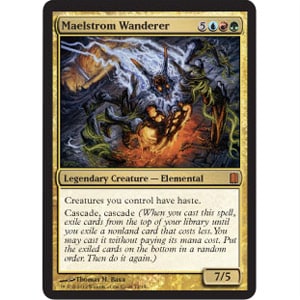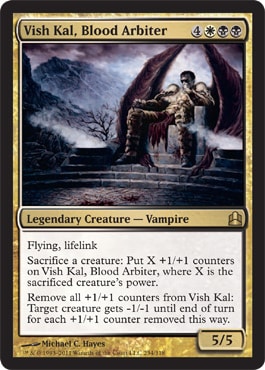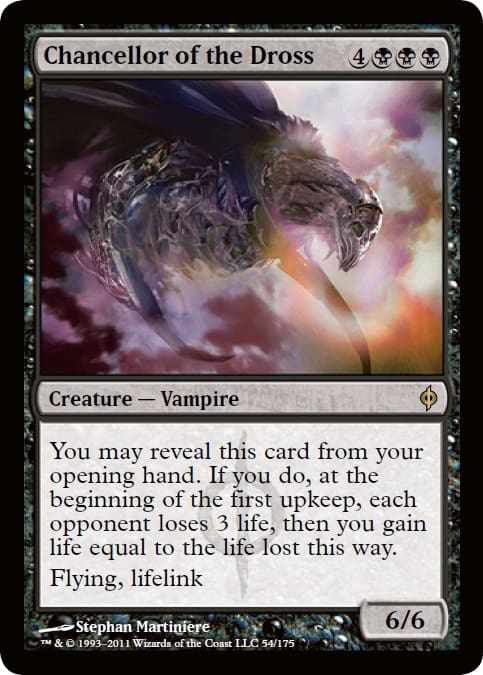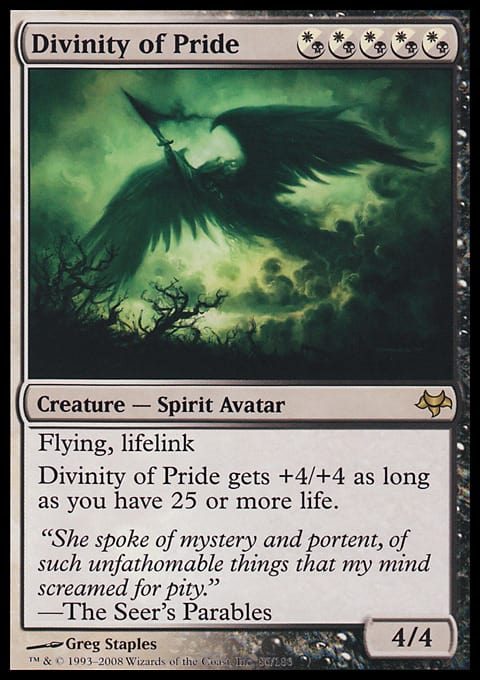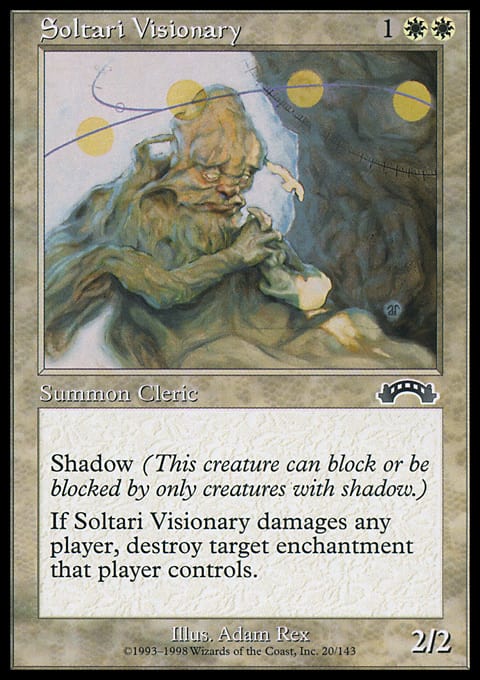As part of my Summer of Deck-Building, I want to dust off some of my under-powered and under-played Commander decks and revamp them. In preparation for this fall’s Return to Ravnica, I was drawn to Teysa, a deck I built around the Orzhov guild’s secondary legend from Guildpact.
The enemy-colored guilds like Orzhov got a big boost from the Eventide set, which featured hybrid-mana cards from opposing colors, and it was then when I finally put Teysa together. It started out, as so many Commander decks do, as a collection of random cards in the relevant colors, and I then added a bunch of token generators to synergize with the commander. Then, for reasons that aren’t exactly clear to me anymore, I decided to add a strong enchantment theme. It turned out to be fantastic if I drew Mesa Enchantress and pretty crappy the rest of the time.
The original decklist in all of its not-much-glory is here:
Orzhov Tokens and Enchantments
- Commander (0)
- Mana (39)
- 13 Plains
- 13 Swamp
- 1 Barren Moor
- 1 Caves of Koilos
- 1 Dust Bowl
- 1 Fetid Heath
- 1 Godless Shrine
- 1 Kor Haven
- 1 Marsh Flats
- 1 Orzhov Basilica
- 1 Orzhova, the Church of Deals
- 1 Secluded Steppe
- 1 Tainted Field
- 1 Terramorphic Expanse
- 1 Orzhov Signet
- Fun with Enchantments (18)
- 1 Flickering Ward
- 1 Soul Stair Expedition
- 1 Bad Moon
- 1 Pacifism
- 1 Attrition
- 1 Aura of Silence
- 1 Cessation
- 1 Ghostly Prison
- 1 Oblivion Ring
- 1 Pillory of the Sleepless
- 1 Righteous War
- 1 Seal of Doom
- 1 Sleeper's Guile
- 1 Sigil of the Empty Throne
- 1 Celestial Ancient
- 1 Evershrike
- 1 Mesa Enchantress
- 1 Skull of Orm
- Token Toys (13)
- 1 Luminarch Ascension
- 1 Sacred Mesa
- 1 Spectral Procession
- 1 Twilight Drover
- 1 Breeding Pit
- 1 Helm of Possession
- 1 Marsh Flitter
- 1 Ghost Council of Orzhova
- 1 Sengir Autocrat
- 1 Conqueror's Pledge
- 1 Cloudgoat Ranger
- 1 Nomads’ Assembly
- 1 Skeletal Vampire
- Critters (15)
- 1 Nightsky Mimic
- 1 Tidehollow Sculler
- 1 Bone Shredder
- 1 Coffin Queen
- 1 Order of Whiteclay
- 1 Reliquary Monk
- 1 Souls of the Faultless
- 1 Vectis Dominator
- 1 Blind Hunter
- 1 Nekrataal
- 1 Voracious Hatchling
- 1 Deathbringer Liege
- 1 Divinity of Pride
- 1 Purity
- 1 Angel of Despair
- Removal/Protection/Acceleration (12)
- 1 Diabolic Edict
- 1 Unmake
- 1 Vindicate
- 1 Martial Coup
- 1 Dawn Charm
- 1 Safe Passage
- 1 Tainted Sigil
- 1 Whispersilk Cloak
- 1 Jayemdae Tome
- 1 Night Dealings
- 1 Citanul Flute
- 1 Promise of Power
I Need a Hero
What first made me want to revisit Orzhov was the release of Vish Kal, Blood Arbiter in last year’s Commander set (procrastination isn’t something that happens to you; it’s a lifestyle choice). As I wrote in my first Ass-Kicking Update,
That self-sacrificing ability is easy to underestimate. My friend Nick has a fantastic Vish Kal deck, and he likes to brag that nothing kills Vish Kal. The life-gain is great, too, allowing you to play a little more aggressively.
There are two more advantages to Vish Kal that I hadn’t realized last year. First, 0-cost creature removal goes a long way toward preventing the abuse of cards such as Lightning Greaves, Whispersilk Cloak, and Darksteel Plate, which are really common in my meta. Second, Vish Kal’s explosiveness should stop games from becoming deadlocked.
Out with Some of the Old
Sometimes, you can revamp a deck just by replacing the commander—for example, my Intet, the Dreamer deck has enough creatures to generate major value from Riku of Two Reflections and enough library manipulation to abuse Maelstrom Wanderer, so I could play those three commanders interchangeably. Usually, though, different commanders play differently enough that you want to make major changes to the whole deck. And let’s face it: If a deck was firing on all cylinders, why would you bother making changes?
Vish Kal is a perfect template for updating a deck from the top down because of how he complements some elements of the original deck but takes it in so many new directions. I’ll try to keep at least some elements of the token theme—being able to sac small critters to Vish Kal makes his removal ability more flexible. I’ll try to make sure Teysa stays on under the new management, and I may be able to enhance the white token theme with cards such as Minion Reflector and Echo Chamber. But I can abandon the disastrous enchantment subtheme and strengthen the deck around the edges.
First Draft
There was no clear plan for the new direction to take this deck, so I just gathered up a two-foot-high stack of cards in the relevant colors and started culling. The closest thing to a method that I used was to divide my fifty “business slots” into fifteen 0- to 2-drops, fifteen 3- to 4-drops, fifteen 5- to 6-drops, and five 7-or-more-mana spells. That ensures that even if the deck falls on its face, it can still curve into Vish Kal and ride him to victory.
Yes, that means I have fifty mana slots: thirty-nine lands, five artifacts, and six critters that help to boost my mana. There is no skimping on mana with a 7-mana commander, especially if it’s the first draft.
And look: a non-green deck without Pilgrim's Eye! As much as I love the Eye, Kor Cartographer and Liliana's Shade are significantly better in these colors.
Orzhov Upgrade
- Commander (0)
- Mana (50)
- 9 Plains
- 10 Swamp
- 1 Barren Moor
- 1 Bojuka Bog
- 1 Caves of Koilos
- 1 City of Shadows
- 1 Dust Bowl
- 1 Evolving Wilds
- 1 Fetid Heath
- 1 Godless Shrine
- 1 Kor Haven
- 1 Marsh Flats
- 1 Mistveil Plains
- 1 Orzhov Basilica
- 1 Orzhova, the Church of Deals
- 1 Salt Flats
- 1 Secluded Steppe
- 1 Sejiri Steppe
- 1 Tainted Field
- 1 Tarnished Citadel
- 1 Terramorphic Expanse
- 1 Vault of the Archangel
- 1 Weathered Wayfarer
- 1 Gold Myr
- 1 Leaden Myr
- 1 Kor Cartographer
- 1 Liliana's Shade
- 1 Solemn Simulacrum
- 1 Armillary Sphere
- 1 Journeyer's Kite
- 1 Orzhov Signet
- 1 Coalition Relic
- 1 Dreamstone Hedron
- Creatures (24)
- 1 Serra Ascendant
- 1 Bloodghast
- 1 Reassembling Skeleton
- 1 Skirsdag High Priest
- 1 Suture Priest
- 1 War Priest of Thune
- 1 Pulsemage Advocate
- 1 Teysa, Orzhov Scion
- 1 Demonlord of Ashmouth
- 1 Grinning Demon
- 1 Kezzerdrix
- 1 Voracious Hatchling
- 1 Bloodlord of Vaasgoth
- 1 Deathbringer Liege
- 1 Divinity of Pride
- 1 Endrek Sahr, Master Breeder
- 1 Shattered Angel
- 1 Deathless Angel
- 1 Purity
- 1 Sunblast Angel
- 1 Xathrid Demon
- 1 Angel of Despair
- 1 Serra Avatar
- 1 Vish Kal, Blood Arbiter
- Spells (24)
- 1 Bloodchief Ascension
- 1 Enlightened Tutor
- 1 Phyrexian Reclamation
- 1 Skullclamp
- 1 Cauldron Haze
- 1 Dawn Charm
- 1 Nim Deathmantle
- 1 Safe Passage
- 1 Tribute to Hunger
- 1 Ajani Goldmane
- 1 Divine Reckoning
- 1 Faith’s Reward
- 1 Purgatory
- 1 Return to Dust
- 1 Well of Lost Dreams
- 1 Wrath of God
- 1 Exquisite Blood
- 1 Increasing Ambition
- 1 Liliana Vess
- 1 Promise of Power
- 1 Sanguine Bond
- 1 Planar Cleansing
- 1 Not of This World
- 1 Exsanguinate
Taking It for a Spin
I put it together in a hurry in order to get in a couple of games last night. I think this is a deck that will survive very well in a long FFA game, but we ended up playing two different formats—Three-Headed Giant and Kingdom—which skewed the results a little. Still, it performed pretty well.
In the first game, Skirsdag High Priest proved to be an all-star (especially with Josh’s sexy Demon tokens, which kept my opponents nice and distracted). As expected, Vish Kal gives me a great deal of control over morbid triggers, and being able to sac a small creature to Vish Kal and create a 5/5 flying blocker is strong. Obviously, I need to put Reaper from the Abyss in the final build.
Other forms of recursion, especially Nim Deathmantle and Faith's Reward, are great with Vish Kal, allowing me to pump Vish Kal up to game-ending levels from out of the blue. The first game ended with my 9/9 Vish Kal doing lethal commander damage1 in his second swing by saccing a Demon token and running a 6/6 Voracious Hatchling through Nim Deathmantle a couple of times. I nearly missed it, though, because I was thinking of keeping my creatures alive instead of putting the game away. More than any commander I’ve ever played, even Ghave and Kresh, Vish Kal demands that you stay alert for opportunities to explode like that.
Sanguine Bond is huge in a deck with so much life-gain—in fact, if I hadn’t been able to win that first game with commander damage, I probably would have finished my opponents with Sanguine Bond damage from that lifelinked deathblow.
The second game was a bit rough—I ended being buried under attacks from four different players. On the plus side, the ability to sweep the board—the whole board—with a Planar Cleansing is fantastic card advantage, and I was able to follow that up by rebuilding with Vish Kal and Chancellor of the Dross. Also, my mana accelerants did their job just fine, allowing me to cast Vish Kal on schedule for 7, 9, and 11 mana.
The bad news is that I had to cast Vish Kal on schedule for 7, 9, and 11 mana. Vish Kal in conjunction with few other creatures can put your opponents in a real bind, but if you find yourself under so much pressure that you can't keep a board presence, a solo Vish Kal is embarrassingly easy to deal with. That was the story of Game 2.
Kal-ibration
As with many Commander decks (or at least many of mine), it tries to do too much. Here’s what it does really well:- Life-gain – Serra Ascendant, Suture Priest, Voracious Hatchling, Divinity of Pride, Shattered Angel, Bloodchief Ascension, Tribute to Hunger, Exquisite Blood, Exsanguinate
- Protection – Deathless Angel, Purity, Cauldron Haze, Dawn Charm, Safe Passage, Not of This World
- Blow Stuff Up – War Priest of Thune, Teysa, Orzhov Scion, Deathbringer Liege, Sunblast Angel, Angel of Despair
One top of all that, it has really strong reach—meaning the ability to deal damage to opponents without using the red zone. And I’m not even talking about the Sanguine Bond/Exquisite Blood combo (which I am determined not to use unless the game goes crazy-long or in response to shenanigans).
Finally, this deck is poised to take full advantage of its greatest strength, life-gain. Being on twice as much life as anyone else is not inherently a good thing, and it can be actively bad if it draws you too many attacks.2 It’s only when that life (or life-gain trigger) becomes a resource that you can use at will that you really get value out of it.
What this deck doesn’t do well is churn out tokens. Especially when I was under pressure, I found that I was trading one-for-one rather than playing a single spell to flood the board with chump-blockers. I really missed cards like Conqueror's Pledge, Skeletal Vampire, or even a lowly Cloudgoat Ranger. Also, Skirsdag High Priest, the only card I saw in both games, would have been a lot more productive if I’d been able to drop a couple of tokens onto the board at once.
On top of that, I realize that I’m not taking advantage of the white utility removal that I was ranting about last week. Return to Dust is among the best spells in the whole freaking game as far as I’m concerned, and Vindicate is beautiful, but I don’t have much else to back them up with. I realize that I’m leaning heavily on Vish Kal for creature removal (Tribute to Hunger is my only one-for-one creature removal because it’s on-theme and deals with anything shrouded that Vish Kal can’t touch), but I need more ways to deal with the artifacts and enchantments that inevitably clog the board, preferably while leaving my toys untouched.
One solution is to pare down the token theme by removing the cards that are most dependent on tokens for effectiveness. Cards that work well with tokens, for example, will underperform when I don’t generate any/many tokens, and they could simply be replaced by token-makers, for example. I can also replace general good stuff (including my cheap, efficient beaters) with other cards that don’t offer the same power/cost but have more synergy with Vish Kal.
Here is the first round of changes to make Vish Kal 2.0:
| This is card is replaced by . . . | . . . this card. |
| Suture Priest | Soltari Visionary |
| Ajani Goldmane | White Sun's Zenith |
| Grinning Demon | Reaper from the Abyss |
| Kezzerdrix | Archon of Justice |
| Orzhov Signet | Eternal Dragon |
| (temporarily) two mana sources (lands or Myr) | Skeletal Vampire and Grave Titan |
Look for more from Vish Kal in the future as I test it out more interactions with this fantastic commander!
1 We run 3HG with 60 life for each team and 31 commander damage instead of 21.
2 This is, to some extent, a rookie mistake, at least when it comes to Commander. Decks that plan to win through commander damage can and should ignore life totals and focus on the deck that has the most threatening game plan. On the other hand, decks that win by grinding combo-prison-lock strategies are usually capable of drawing a concession from any deck with a three- or four-figure life total, and so they only need to worry about life-gain when it reaches arbitrarily large amounts.













